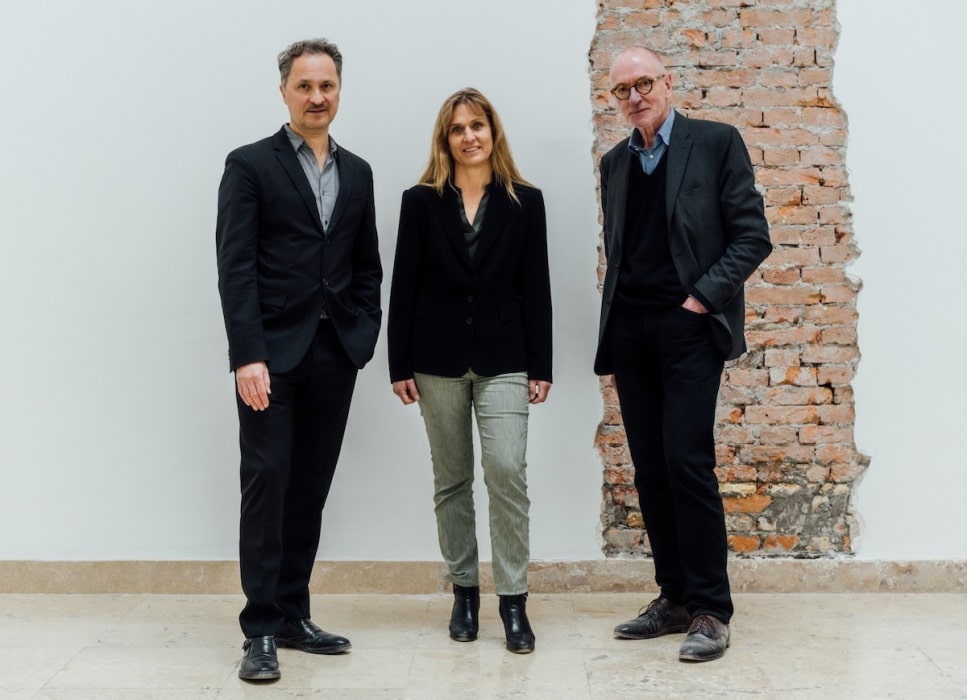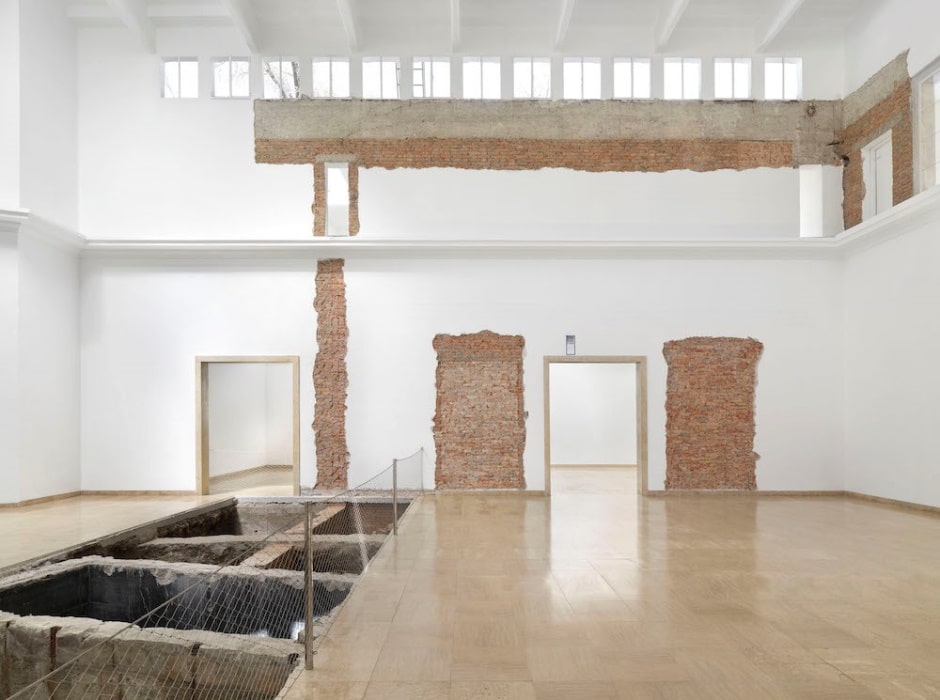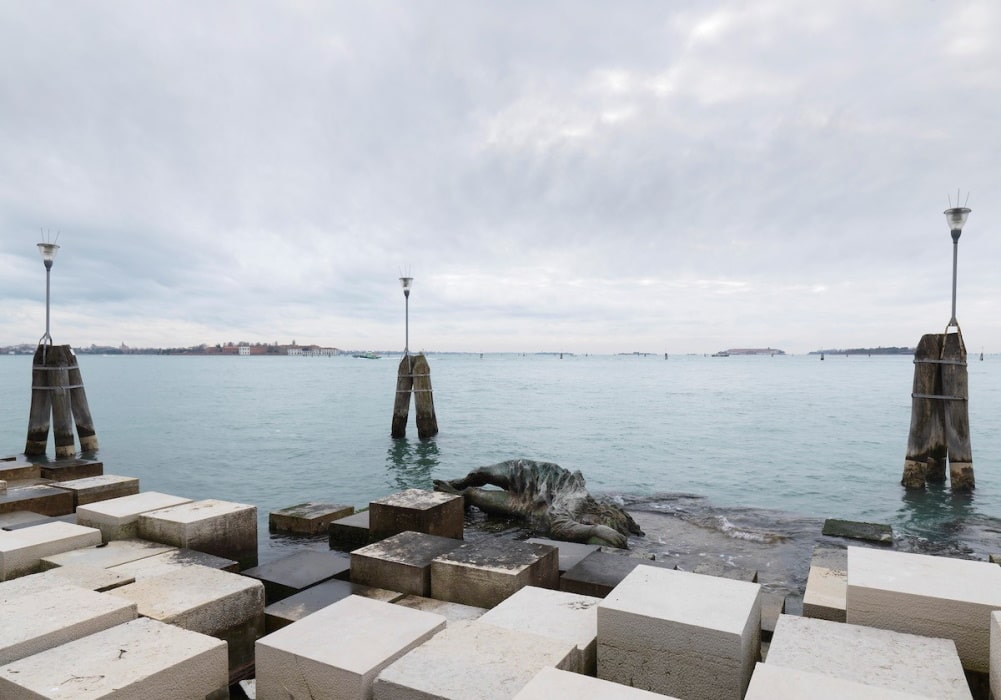Having been postponed in 2021 due to the COVID-19 pandemic, the Biennale finally got underway today. The German Pavilion was opened in the presence of Katja Keul, Minister of State at the German Foreign Office, and Ulrich Raulff, President of ifa – Institut für Auslandsbeziehungen, both of whom traveled from Germany to attend the event.
“The much-discussed dawning of a new era is also a watershed in international cultural policy. It is now even more important to protect endangered and persecuted artists and to reinforce dialog with those committed to democracy and human rights. To this end, at this time, we need places like the Biennale where artists from around the world can think together about issues that connect us as a global community.”
Katja Keul, Minister of State at the German Foreign Office, on the occasion of the opening of the German Pavilion in Venice
Maria Eichhorn’s contribution to the German Pavilion, entitled Relocating a Structure. German Pavilion 2022, 59th International Art Exhibition – La Biennale di Venezia, is curated by Yilmaz Dziewior, Director of the Museum Ludwig, Cologne.
“In her site-specific work, Maria Eichhorn deals in multilayered ways with questions of our time: ownership and property, the ongoing impact of the past on the present, and the power relations involved in this process, which are precisely relocated by the artist in her work. Against the backdrop of the current state of world politics, these issues could not be more urgent.”
Ulrich Raulff, President of ifa
Germany’s contribution to the 59th International Art Exhibition – La Biennale di Venezia was commissioned by the Federal Foreign Office and realized in cooperation with ifa – Institut für Auslandsbeziehungen. The German Pavilion has been open for a preview since Tuesday and will be open to the general public from tomorrow, April 23, until November 27, 2022.
“Maria Eichhorn has engaged with the building’s history and architecture and taken a different, larger view of Venice as a whole. Among others, she focused on the question of how fascist tendencies and counter-positions continue to resonate today. Her subtle, incisive approach to these questions fascinated me throughout the preparatory phase, and the result is all the more compelling for it.”
Yilmaz Dziewior

Maria Eichhorn’s contribution was opened in the presence of Katja Keul, Minister of State at the German Foreign Office.
The artist Maria Eichhorn has been invited by curator Yilmaz Dziewior to create the German contribution to the 59th International Art Exhibition – La Biennale di Venezia.
In her project Relocating a Structure. German Pavilion 2022, 59th International Art Exhibition – La Biennale di Venezia, Maria Eichhorn examines the eventful history of the German Pavilion since the beginnings of the Biennale and the powerful resistance art demonstrates when it focuses on social conditions.
Relocating a Structure consists of a number of interacting components. Eichhorn’s initial idea was to relocate the German Pavilion for the duration of the Biennale and then to faithfully reassemble it on its original site. The temporary relocation of the building would leave an empty space, increasing the undeveloped area of the Giardini, originally designed as a public park, as well as the visual and spatial environment around the adjacent pavilions. The German Pavilion’s absence would open up space for movement, reflection, and an examination of the conditions to which art is exposed in the context of the Biennale with its national pavilions.
“The German Pavilion represents a challenge for artists on several completely different levels. With every attempt at deconstruction, one is confronted with it yet again. I regard the German Pavilion not as isolated, but as part of an ensemble and engaged in interplay with other pavilions and other country participations in terms of national-territorial and geopolitical, global-economic, and ecological developments.”
– Maria Eichhorn
Eichhorn’s reflections on the relocation of the German Pavilion were accompanied by an analysis of the actual physical structure of the pavilion, which principally consists of two buildings: the Bavarian Pavilion built in 1909 and the extensions carried out by the Nazis in 1938, as seen today. Where is the original structure located? Where do the extensions and the reconstruction begin?
Eichhorn had the foundations of the pavilion excavated and layers of plaster removed from its walls to expose the joins between the earlier structure and the remodeled building. In order to comprehend the radical reconstruction and extension work, she also had the outlines of the window openings and doorways from 1909 laid bare. In this way, the original, hidden pavilion has been rendered visible and tangible.

Explanatory wall texts have been added to the exposed areas in English, German, and Italian. The texts were drawn on the wall using pencil and stencils to create fine outlines that were then filled in using a brush and white paint.
Not only were the transitions between the original architecture and the extension and reconstruction work revealed, but also the shift in dimensions. While the proportions of the Bavarian Pavilion were oriented to a human scale, the 1938 additions to the side rooms, the main room, and especially the facade dwarf visitors, producing an intimidating effect.
The other components of Relocating a Structure include a comprehensive publication and guided tours to historical places of resistance and remembrance in Venice, conducted twice weekly during the Biennale. The publication brings together essays and studies on the history of the Biennale and the German Pavilion, as well as on broader aspects embracing art history, philosophy, urban sociology, and politics. In addition, a brochure has been published to accompany the guided tours of places commemorating the anti-fascist resistance and the deportation and murder of the Jewish population during the German occupation from 1943 to 1945. For these tours, Eichhorn collaborated with the Istituto veneziano per la storia della Resistenza e della società contemporanea (Iveser).
“The title of Maria Eichhorn’s project, Relocating a Structure, can be interpreted in a figurative sense. ‘Relocating a structure’ to a new context may refer not only to the architecture and history of the German Pavilion, but also to fundamental issues of human existence and ethical responsibility.”
– Yilmaz Dziewior

City Tours and Brochure
As part of Maria Eichhorn’s Relocating a Structure, tours will be offered twice weekly during the Biennale to monuments and places that commemorate the activities of the anti-fascist resistance and the deportation of the Jewish population. The first guided tour will take place on April 28, 2022, to mark the seventy-seventh anniversary of the Allied liberation of Venice on April 28, 1945, from the German occupation. The city tours are organized in collaboration with the Istituto veneziano per la storia della Resistenza e della societá contemporanea (Iveser) and are conducted by Giulio Bobbo and Luisella Romeo.
One tour is dedicated to the Jewish Ghetto. A second tour goes from Santa Lucia station to the Stazione Marittima (Port and Terminal) via Santa Maria Maggiore prison. A third sets out from the Arsenale and continues to Riva dei Sette Martiri, via the Monument to the Partisan Woman of Veneto by Leoncillo and the Monument to Italian Military Internees and Prisoners of War, and on to the Monument to the Partisan Woman by Augusto Murer.
Dates and further information for online bookings can be found here. The tours will be in English (or Italian if requested by the group of participants). Participation is free. Current COVID-19 regulations will apply. The city tours will be accompanied by a free brochure: Giulio Bobbo, Places of Remembrance and Resistance, edited by Yilmaz Dziewior, English / German / Italian, 30 pages.
WHAT?
Exhibition Maria Eichhorn: Relocating a Structure. German Pavillon 2022,59th International Art Exhibition – La Biennale di Venezia
WHERE?
German Pavillon, Giardini della Biennale
Venice, Italy
WHEN?
Preview: Wednesday, 20. – Friday, 22. April 2022, 10 am – 7 pm
Opening: Friday, 22. April 2022, noon
Opening hours: Saturday, 23. April – Sunday, 27. November 2022
23. April to 25. September 2022: Tuesdays to Sundays, 11 am – 7 pm
27. September – 27. November 2022: Tuesdays to Sundays, 10 am – 6 pm





